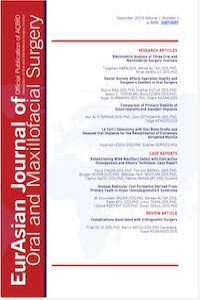Evaluation of the Prevalence of Temporomandibular Joint Disorder and Bruxism in Individuals with Obstructive Sleep Apnea Syndrome
Evaluation of the Prevalence of Temporomandibular Joint Disorder and Bruxism in Individuals with Obstructive Sleep Apnea Syndrome
___
- 1. Taş E., Bilazer M., Şahin E., Gürsel A.O. Obstrüktif uyku apne sendromlu hastalarda sefalometrik analiz sonuçları. KBB-Forum 2007; 6(2): 49-56.
- 2. Abbott M.B., Donnelly L.F., Dardzinski B.J., Poe S.S., Chini B.A., Amin R.S. Obstructive sleep apnea: MR imaging volume segmentation analysis. Pediatric Imaging 2004; 232: 889-895.
- 3. Koca C.G., Gümrükçü Z., Bilgir E. Does clinical findings correlate with magnetic resonance imaging (MRI) findings in patients with temporomandibular joint (TMJ) pain? A cross sectional study. Med Oral Patol Oral Cir Bucal 2020; 25(4): 495-501.
- 4. Odabaş B., Gündüz Arslan S. Temporomandibular eklem anatomisi ve rahatsızlıkları. Dicle Tıp Dergisi. 2008; 35(1): 77-85.
- 5. Bonato L.L., Quinelato V., De Felipe Cordeiro P.C., De Sousa E.B., Tesch R., Casado P.L. Association between temporomandibular disorders and pain in other regions of the body. Journal of Oral Rehabilitation 2016; 44(1): 9-15.
- 6. Koca C.G., Yıldırım B., Bilgir E. Effects of bruxism on temporomandibular joint internal derangement in patients with unilateral temporomandibular joint pain: The role of magnetic resonance imaging diagnostics. CRANIO 2021 DOI: 10.1080/08869634.2021.1918959.
- 7. Pires PF, Castro EM, Pelai EB, de Arruda ABC, Bigaton DR. Analysis of the accuracy and reliability of the shortform Fonseca Anamnestic Index in the diagnosis of the myogenous temporomandibular disorder in women. Braz J Phys Ther. 2018; 22: 276-282.
- 8. Kheirabadi GR, Maracy MR, Akbaripour S, Masaeli N. Psychometric properties and diagnostic accuracy of the Edinburgh Postnatal Depression Scale in a sample of Iranian women. Iran J Med Sci. 2012, 37: 32-38.
- 9. Yazıcı E, Yazıcı AB. Gebelik ve postpartum döneminde psikiyatrik bozukluklar klinik ve tedavi başvuru kitabı. Bölüm adı: Postpartum depresyon Editör: Prof. Dr. Faruk Uğuz. Birinci basım, 2017; sfy 31-49. Vizyon basımevi, İstanbul, Türkiye
- 10. Lobbezoo F., Ahlberg J., Glaros A.G., Kato T., Koyano K., Lavigne G.J., de Leeuw R., Manfredini D., Svensson P., Winocur E. Bruxism defined and graded: an international consensus. Journal of Oral Rehabilitation 2013; 40(1): 2-4.
- 11. Paesani D.A., Lobbezoo F., Gelos C., Guarda-Nardini L., Ahlberg J., Manfredini D. Correlation between selfreported and clinically based diagnoses of bruxism in temporomandibular disorders patients. Journal of Oral Rehabilitation 2013 DOI: 10.1111/joor.12101.
- 12. Zimmerman M., Aloia M. Sleep-disordered breathing and cognition in older adults. Curr Neurol Neurosci Rep 2012; 12: 537-546.
- 13. Tahrani A., Somers V., Caples S. Obstructive sleep apnea, cardiovascular disease, and diabetes. CurrrbOpin Pulm Med 2013; 19: 631-638.
- 14. LeResche L., saunders K., Von Korff MR., Barlow W., Dworkin S.F. Use of exogenous hormones and risk of temporomandibular disorder pain. Pain 1997; 69: 153-160.
- 15. Young T., Peppard P.E., Taheri S. Excess weight and sleepdisordered breathing. J Appl physiol 2005; 99: 1592-1599.
- 16. Veiga D.M., Cunali R., Bonotto D., Cunali P.A. Sleep quality in patients with temporomandibular disorder: a systematic review. Sleep Science 2013; 6(3): 120-124.
- 17. Zwiri A.M.A., Ghani Z.A., Husein A., Phaik K.S., Kassim N.K., Zainal S.A., Samsudin A.R. Obstructive sleep apnea and its relation with temporomandibular disorders: a narrative review. Journal of International Oral Health 2020; 12: 8-14.
- 18. Pires PF, Castro EM, Pelai EB, de Arruda ABC, Bigaton DR. Analysis of the accuracy and reliability of the shortform Fonseca Anamnestic Index in the diagnosis of the myogenous temporomandibular disorder in women. Braz J Phys Ther. 2018; 22: 276-282.
- 19. dos Santos Berni KC, Dibai-Filho AB, Rodrigues-Bigaton D. Accuracy of the Fonseca anamnestic index in the ıdintification of myogenous temporomandibular disorder in femalen community cases. J Bodywork & Movement Therapies. 2015; 19(3): 405-409.
- 20. Smith M.T., Wickwire E.M., Grace E.G., Edwards R.R., Buenaver L.F., Peterson S., Klick B., Haythornthwaite J.A. Sleep disorders and their association with laboratory pain sensitivity in temporomandibular joint disorder. Sleep 2009; 32(6): 779-790.
- 21. Edwards R.R., Grace E., Peterson S., Klick B., Haythornthwaite J.A., Smith M.T. Sleep continuity and architecture: associations with paim-inhibitory processes in patients with temporomandibular joint disorder. Eur J Pain 2009; 13(10): 1043-1047. Koca C.G. et al. Eurasia J Oral Maxillofac Surg 2023 May;2(2): 29-34 Page 34
- 22. Sanders A.E., Essick G.K., Fillingim R., Knott C., Ohrbach R., greenspan J.D., Diatchenko L., Maixner W., Dubner R., Bair E., Miller W.E., Slade G.D. Sleep apnea symptoms and risk of temporomandibular disorder: OPPERA cohort JDR Clin Res Supp 2013; 92(1): 70-77.
- 23. Cunali P.A., Almeida F.R., Santos C.D., Valdrighi N.Y., Nascimento N.S., Dal’Fabbro C., Tufik S., Bittencourt L., R., A. Prevalence of temporomandibular disorders in obstructive sleep apnea patients referred for oral appliance therapy. J orofac pain 2009; 23: 339-344.
- 24. Jokubauskas J., Baltrusaityte A. Relationship between obstructive sleep apnoea syndrome and sleep bruxism: a systematic review. Journal of Oral Rehabilitation 2017; 44: 144-153.
- 25. Saito M., Yamaguchi T., Mikami S., Watanabe K., Gotouda A., Okada K., Hishikawa R., Shibuya E., Lavigne G. Temporal association between sleep apnea-hypopnea and sleep bruxism events. J Sleep Res 2013; 23: 196-203.
- Başlangıç: 2020
- Yayıncı: Ağız ve Çene Yüz Cerrahisi Birliği Derneği
Primary Intraosseous Squamous Cell Carcinoma Coexisting with a Radicular Cyst: Case Report
Merve ARICI, Okan DURAN, Orçun TOPTAŞ, Çetin BORAN
Cansu Gül KOCA, Bengisu YILDIRIM, Muhammed Fatih ÇİÇEK
Patient-Fitted Total Temporomandibular Joint Prosthesis: A Case Series
Seçil ÇUBUK, Palin ÇİFTÇİOĞLU, Burak BAYRAM
Maxillary Midpalatal Sagittal Fracture: A Case Report
Assessment of the Level of Knowledge and Awareness of Dentists About Antibiotic Prophylaxis
Selen ONAT, Senanur DURUAY, Alptuğ KENDİRCİ, Serhat POLAT, Nur ALTIPARMAK
Conservative Management of Large Dentigerous Cysts in Children
Ayşe ÖZCAN KÜÇÜK, Mahmut KOPARAL, Aydın KESKİNRÜZGAR
Diagnostic Handicap: RHABDOMYOSARCOMA
Tolga BAYAR, Ebru Deniz KARSLI, Betül TAŞ ÖZYURTSEVEN, Metin GÜNGÖRMÜŞ
Cihan VAROL, Yavuz FINDIK, Doç. Dr. Timuçin BAYKUL, Gülperi KOÇER, Mehmet Fatih ŞENTÜRK, Tayfun YAZICI, Mustafa Yasin YETER
Dentigerous Cyst Associated with Ectopic Canine of the Maxilla: A Case Report
